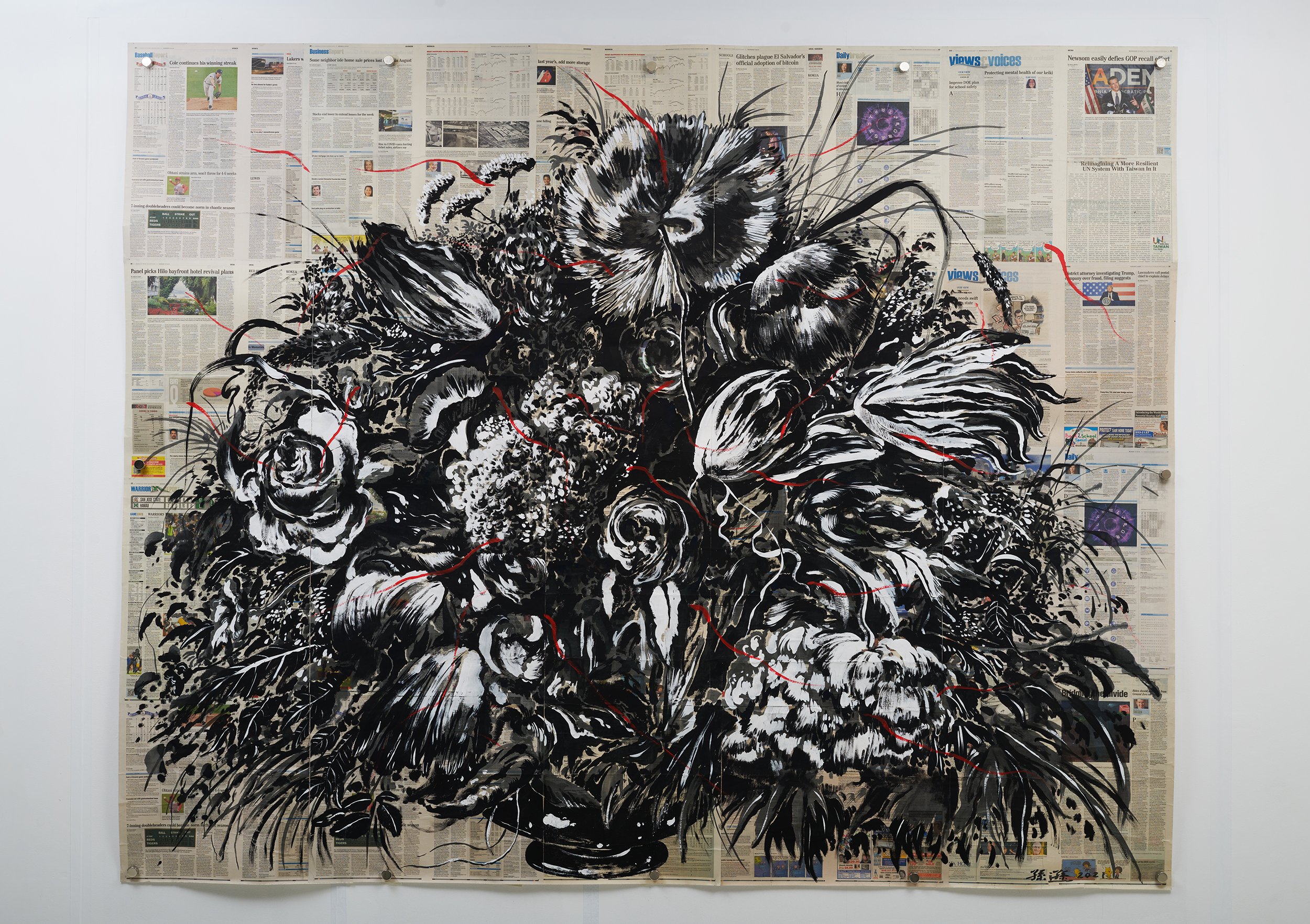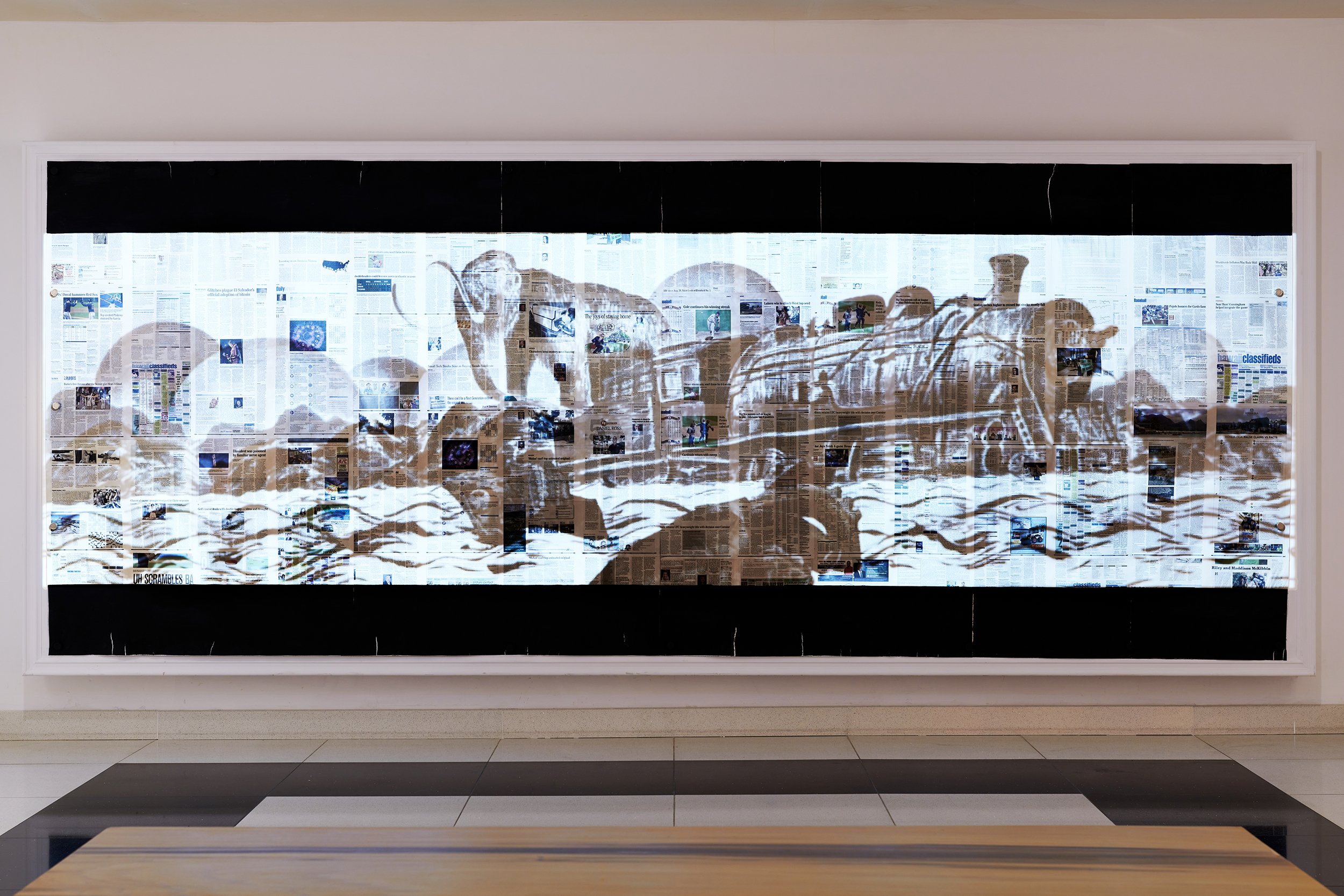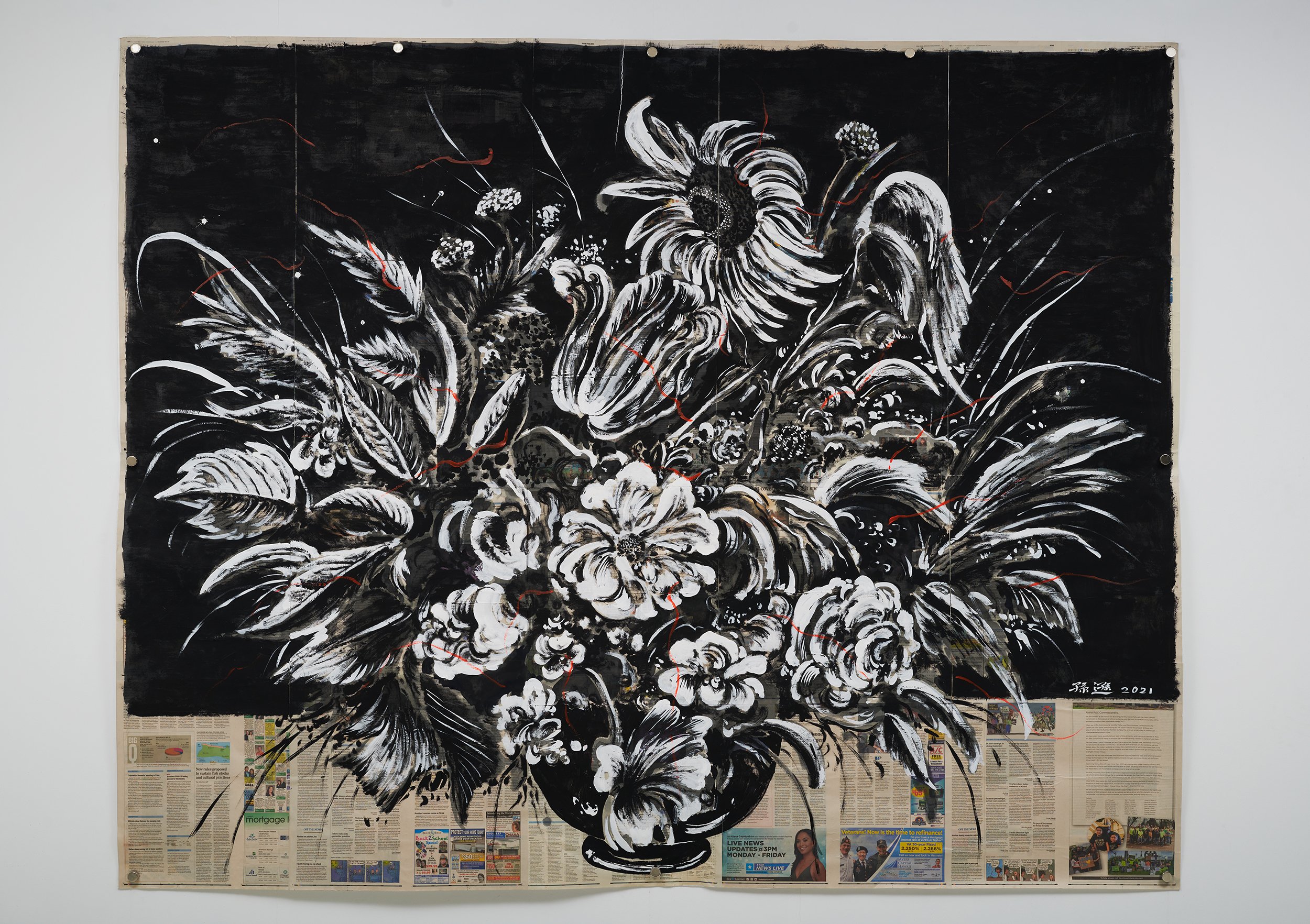hawai‘i triennial 2022
@ ROYAL HAWAIIAN CENTER
Sun Xun
b. 1980, Fuxin, China
lives and works in Beijing
[TOP LEFT] Sun Xun, 古老的远方拔开现实的迷雾 The Ancient Distance Uncover the Mystery of Reality and 迷一样的历史隐藏在我们看不见的事物之中(之一)The Mysterious History Lies in What We Can’t See No.1 , 2021, ink, Universalfarbe all-purpose paint and acrylic on newspaper; Mythological Time (stills), 2016, HD animation with color and sound, 12 mins, 44 secs; 迷一样的历史隐藏在我们看不见的事物之中(之二)The Mysterious History Lies in What We Can’t See No.2, 2021, ink, Universalfarbe all-purpose paint and acrylic on newspaper; Royal Hawaiian Center, HT22, Waikīkī. Courtesy of the artist and Hawai‘i Contemporary. Photos: Christopher Rohrer and Lila Lee.
Sun Xun is hailed as one of China’s most dynamic contemporary artists, best known for his large-scale mural work and stop-motion animation videos created from thousands of ink drawings and woodcuts. Beyond evocative titles, his works often contain little dialogue and rely on sound and images of dystopian worlds to explore the slippery dynamics of memory, history, culture, and politics.
As a graduate of the printmaking department at the China Academy of Art in Hangzhou, he quickly incorporated an interest in film and video and other contemporary inspirations into his practice. Drawing upon the printmaking and painting fundamentals of Albrecht Dürer and Jan van Eyck, Sun combined an interest in Chinese new media art of the 1990s with an appreciation for social investigations around themes of intolerance and racism, particularly those associated with Apartheid found in the animated drawings of William Kentridge and gestural paintings of Marlene Dumas. It is this confluence of influences, alongside the merging of old technology with forward-thinking concepts, that establishes the foundation for Sun to transcend geographic boundaries and defy cultural definitions.
Sun’s Mythological Time (2016) is included in HT22 at the Royal Hawaiian Center in Waikīkī. The film invites viewers on an imaginative journey through the transformation of the artist’s hometown of Fuxin in northeastern China; now facing economic depletion, Fuxin was once home to the largest open-pit coal mine in Asia and the pride of Chinese modern industry. Sun’s animated film is composed of thousands of hand-drawn images in his distinctive stark monochromatic style and depicts a bewildering panorama of mythological creatures and lone figures traversing a post-industrial dystopian landscape. Expertly combining printmaking and painting techniques—ranging from woodcut, gestural dry-ink brush, and fine-line gongbi painting—Sun intertwines fantastical images that invoke the spiritual realm, folklore, and historical narratives in a potent imaginative cabinet of curiosities. A recurring theme of time in Sun’s work refers to his belief that time and life are underpinned by one’s perception of reality, and the passage of time is signified in Mythological Time by images of fossilized insects, abandoned monuments, and the gnarled roots of pine trees—a symbol of longevity and prosperity in Chinese culture.
The viewer is mesmerized by surrealist images of mythological creatures transforming into monuments, and captivated by a bold orchestral score enhanced with sweeping sounds of nature. The film ends with the transformation of a winged, four-legged creature into a Chinese stone stele, which then becomes the Soviet monument Worker and the Kolkhoz Woman (Rabochiy i Kolkhoznitsa) (1937), and lastly transfigures into the Statue of Liberty before exploding into Chinese and English text: ‘We Must Build an Idol to Resist fear’, and lingering on an image of a room bleakly filled with nine empty armchairs.
Upon invitation to participate in HT22, Sun chose to draw on newsprint gathered in Hawai‘i in 2020 during the pandemic. These works are presented with Mythological Time and together provide a visual narrative that draws on rich traditions of ink painting and printmaking, combined with an active voice of social and political change and a deep concern for the manipulation of the media, official narratives, and collective memory.
Sun Xun. Courtesy of the artist.
Sun Xun was born in 1980 in Fuxin, China and studied printmaking at the China Academy of Fine Arts, Hangzhou (2001–05). His interest in traditional art forms, such as ink painting and woodcut prints, is reflected in the deft craftsmanship that characterizes his animated films, which often consist of energetically composed, hand-drawn single frames that can number up to five thousand. Sun Xun’s works often highlight the absurd incongruities between authorised histories and personal recollections, and are particularly concerned with how history can be manipulated, interrogating the differences between official narratives presented by public agencies, politicians and the media — and more marginalised accounts that stem from ordinary people’s experiences.
In 2006, he founded Pi Animation, where he and a handful of employees use high powered computer to create his films. The artist has been included in exhibitions at the Guggenheim Museum in New York, the Hammer Museum in Los Angeles, and the Minsheng Art Museum in Shanghai. Sun lives and works in Beijing, China.







